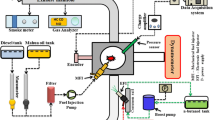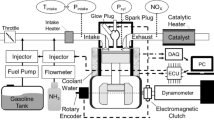Abstract
The effects of air and exhaust gas recirculation (EGR) dilution of a spark ignition engine fueled with methanol under different loads were studied by experiment in this paper. Such as ignition delay, combustion center (CA50), IMEP, break thermal efficiency (BTE) and other parameters were investigated to assess the combustion performance. And discussed in depth the balance between NOx emissions and economic performance represented by brake specific fuel consumption (BSFC). The results showed that combustion progress such as ignition delay, combustion duration and CA50 were more sensitive on the changes of EGR, introducing EGR under the same dilution rate prolonged combustion process. Air-EGR dilution showed the best improvement of IMEP and break thermal efficiency, except the optimal area, increasing EGR rate will decreased IMEP and BTE. Air-EGR dilution strategy showed the best improvement on BSFC than air dilution than EGR dilution. Under light load and high load, when the lowest BSFC was obtained, NOx emissions were less than 0.5 g/kWh with air-EGR dilution strategy.
Similar content being viewed by others
Abbreviations
- BSFC:
-
brake specific fuel consumption
- BTE:
-
break thermal efficiency
- CA10:
-
crank angle position between ignition timing to 10 % heat release
- CA50:
-
crank angle position between ignition timing to 50 % heat release
- CA10-90:
-
crank angle duration between 90 % and 10 % heat release
- COVIMEP :
-
variation coefficient of IMEP
- EGR:
-
exhaust gas recirculation
- GDI:
-
gasoline direct injection
- IMEP:
-
indicated mean effective pressure
- PRR:
-
pressure rise rate
References
Abd-Alla, G. H. (2002). Using exhaust gas recirculation in internal combustion engines: A review. Energy Conversion and Management 43, 8, 1027–1042.
Benajes, J., García, A., Monsalve-Serrano, J., Balloul, I. and Pradel, G. (2016). An assessment of the dual-mode reactivity controlled compression ignition/ conventional diesel combustion capabilities in a EURO VI medium-duty diesel engine fueled with an intermediate ethanol-gasoline blend and biodiesel. Energy Conversion and Management, 123, 381–391.
Bhasker, J. P. and Porpatham, E. (2017). Effects of compression ratio and hydrogen addition on lean combustion characteristics and emission formation in a Compressed Natural Gas fuelled spark ignition engine. Fuel, 208, 260–270.
Bo, Z., Ji, C. and Wang, S. (2017). Investigation on the lean combustion performance of a hydrogen-enriched n-butanol engine. Energy Conversion and Management, 136, 36–43.
Chen, Z., Wang, L. and Zeng, K. (2019a). Comparative study of combustion process and cycle-by-cycle variations of spark-ignition engine fueled with pure methanol, ethanol, and n-butanol at various air-fuel ratios. Fuel, 254, 115683.
Chen, Z., Wang, L., Zhang, Q., Zhang, X., Yang, B. and Zeng, K. (2019b). Effects of spark timing and methanol addition on combustion characteristics and emissions of dual-fuel engine fuelled with natural gas and methanol under lean-burn condition. Energy Conversion and Management, 181, 519–527.
Distaso, E., Amirante, R., Cassone, E., De Palma, P., Sementa, P., Tamburrano, P. and Vaglieco, B. M. (2020). Analysis of the combustion process in a lean-burning turbulent jet ignition engine fueled with methane. Energy Conversion and Management, 223, 113257.
Duan, X., Li, Y., Liu, J., Guo, G., Fu, J., Zhang, Q., Zhang, S. and Liu, W. (2019a). Experimental study the effects of various compression ratios and spark timing on performance and emission of a lean-burn heavy-duty spark ignition engine fueled with methane gas and hydrogen blends. Energy, 169, 558–571.
Duan, X., Liu, Y., Lai, M. C., Guo, G., Liu, J., Chen, Z. and Deng, B. (2019b). Effects of natural gas composition and compression ratio on the thermodynamic and combustion characteristics of a heavy-duty lean-burn SI engine fueled with liquefied natural gas. Fuel, 254, 115733.
Garcia, G., Arriola, E., Chen, W. H. and De Luna, M. D. (2021). A comprehensive review of hydrogen production from methanol thermochemical conversion for sustainability. Energy, 217, 119384.
Geng, P., Zhang, H., Yang, S. and Yao, C. (2015). Comparative study on measurements of formaldehyde emission of methanol/gasoline fueled SI engine. Fuel, 148, 9–15.
Gong, C., Zhang, Z., Sun, J. and Liu, F. (2021). Optimization on timings of injection and spark of a high compression-ratio stratified-charge methanol engine under ultra-lean burn. Fuel, 285, 119227.
Hong, W., Yuan, C., Xie, F., Su, Y. and Chen, J. (2018). Particulate matter and particle-bound PAHs emissions from gasoline direct injection (GDI) engine with methanol-gasoline blended fuel during start. Int. J. Automotive Technology 19, 4, 717–726.
Hu, E., Huang, Z., Bing, L., Zheng, J. and Gu, X. (2009). Experimental study on combustion characteristics of a spark-ignition engine fueled with natural gas-hydrogen blends combining with EGR. Int. J. Hydrogen Energy 34, 2, 1035–1044.
Ibrahim, A. and Bari, S. (2009). A comparison between EGR and lean-burn strategies employed in a natural gas SI engine using a two-zone combustion model. Energy Conversion and Management 50, 12, 3129–3139.
İlhak, M. İ., Akansu, S. O., Kahraman, N. and Ünalan, S. (2018). Experimental study on an SI engine fuelled by gasoline/acetylene mixtures. Energy, 151, 707–714.
İlhak, M. İ., Tangöz, S., Akansu, S. O. and Kahraman, N. (2019). An experimental investigation of the use of gasoline-acetylene mixtures at different excess air ratios in an SI engine. Energy, 175, 434–444.
Jung, D. and Lee, S. (2018). An investigation on the potential of dedicated exhaust gas recirculation for improving thermal efficiency of stoichiometric and lean spark ignition engine operation. Applied Energy, 228, 1754–1766.
Leach, F. C., Stone, R., Richardson, D., Turner, J. W., Lewis, A., Akehurst, S. and Cracknell, R. (2018). The effect of oxygenate fuels on PN emissions from a highly boosted GDI engine. Fuel, 225, 277–286.
Lee, S., Ozaki, K., Iida, N. and Sako, T. (2015). A potentiality of dedicated EGR in SI engines fueled by natural gas for improving thermal efficiency and reducing NOx emission. SAE Int. J. Engines 8, 1, 238–249.
Li, R., Liu, Z., Han, Y., Tan, M., Xu, Y., Tian, J., Chong, D., Chai, J., Liu, J. and Li, Z. (2017). Experimental and numerical investigation into the effect of fuel type and fuel/air molar concentration on auto-ignition temperature of n-heptane, methanol, ethanol, and butanol. Energy & Fuels 31, 3, 2572–2584.
Li, W., Liu, Z., Wang, Z. and Xu, Y. (2014). Experimental investigation of the thermal and diluent effects of EGR components on combustion and nox emissions of a turbocharged natural gas SI engine. Energy Conversion and Management, 88, 1041–1050.
Li, W., Liu, Z., Wang, Z., Xu, Y. and Wang, J. (2015). Experimental and theoretical analysis of effects of N2, O2 and ar in excess air on combustion and NOx emissions of a turbocharged NG engine. Energy Conversion and Management, 97, 253–264.
Liu, H., Wang, Z., Long, Y., Xiang, S., Wang, J. and Wagnon, S. W. (2015). Methanol-gasoline dual-fuel spark ignition (DFSI) combustion with dual-injection for engine particle number (PN) reduction and fuel economy improvement. Energy, 89, 1010–1017.
Liu, J. and Dumitrescu, C. E. (2019). Methodology to separate the two burn stages of natural-gas lean premixed-combustion inside a diesel geometry. Energy Conversion and Management, 195, 21–31.
Ogawa, H., Azuma, K. and Miyamoto, N. (2007). Combustion control and operating range expansion in an homogeneous charge compression ignition engine with suppression of low-temperature oxidation by methanol: influence of compression ratio and octane number of main fuel. Int. J. Engine Research 8, 1, 139–145.
Prasad, B. N., Pandey, J. K. and Kumar, G. N. (2020). Impact of changing compression ratio on engine characteristics of an SI engine fueled with equi-volume blend of methanol and gasoline. Energy, 191, 116605.
Ravi, K., Bhasker, J. P. and Porpatham, E. (2017). Effect of compression ratio and hydrogen addition on part throttle performance of a LPG fuelled lean burn spark ignition engine. Fuel, 205, 71–79.
Shi, L., Ji, C., Wang, S., Cong, X., Su, T. and Shi, C. (2019). Impacts of dimethyl ether enrichment and various injection strategies on combustion and emissions of direct injection gasoline engines in the lean-burn condition. Fuel, 254, 115636.
Soltic, P., Hilfiker, T. and Hänggi, S. (2021). Efficient light-duty engine using turbulent jet ignition of lean methane mixtures. Int. J. Engine Research 22, 4, 1301–1311.
Wang, L., Chen, Z., Zhang, T. and Zeng, K. (2019). Effect of excess air/fuel ratio and methanol addition on the performance, emissions, and combustion characteristics of a natural gas/methanol dual-fuel engine. Fuel, 255, 115799.
Wei, H., Gao, D. and Zhou, L. (2016). Experimental study on laminar flame characteristics of methane-PRF95 dual fuel under lean burn conditions. Fuel, 185, 254–262.
Wei, H., Zhang, R., Chen, L., Pan, J. and Wang, X. (2021). Effects of high ignition energy on lean combustion characteristics of natural gas using an optical engine with a high compression ratio. Energy, 223, 120053.
Wu, B., Wang, L., Shen, X., Yan, R. and Dong, P. (2016). Comparison of lean burn characteristics of an SI engine fueled with methanol and gasoline under idle condition. Applied Thermal Engineering, 95, 264–270.
Xie, F., Hong, W., Su, Y., Zhang, M. and Jiang, B. (2017). Effect of external hot EGR dilution on combustion, performance and particulate emissions of a GDI engine. Energy Conversion and Management, 142, 69–81.
Yu, X., Guo, Z., He, L., Dong, W., Sun, P., Du, Y., Li, Z., Yang, H., Wang, S. and Wu, H. (2019). Experimental study on lean-burn characteristics of an SI engine with hydrogen/gasoline combined injection and EGR. Int. J. Hydrogen Energy 44, 26, 13988–13998.
Zhao, L., Qi, W., Wang, X. and Su, X. (2020). Potentials of EGR and lean mixture for improving fuel consumption and reducing the emissions of high-proportion butanol-gasoline engines at light load. Fuel, 266, 116959.
Zhao, L., Wang, X., Wang, D. and Su, X. (2020). Investigation of the effects of lean mixtures on combustion and particulate emissions in a DISI engine fueled with bioethanol-gasoline blends. Fuel, 260, 116096.
Zheng, M., Reader, G. T. and Hawley, J. G. (2004). Diesel engine exhaust gas recirculation—A review on advanced and novel concepts. Energy Conversion & Management, 45, 883–900.
Zhuang, Y., Qian, Y. and Hong, G. (2018). Lean burn performance of a spark ignition engine with an ethanol–gasoline dual injection system. Energy & Fuels 32, 3, 2855–2868.
Acknowledgement
This work was financially supported by National Natural Science Foundation of China (Grant No. 51876079), funded by the special fund for basic scientific research in central colleges and universities, funded by State Key Laboratory of Automotive Simulation and Control (ascl-zytsxm-202014), Science and Technology Research Project of Education Department of Jilin Province (JJKH20221002KJ), Key project of Social Development Science and Technology Department of Science and Technology Department of Jilin Province (20220203156SF).
Author information
Authors and Affiliations
Corresponding author
Additional information
Publisher’s Note
Springer Nature remains neutral with regard to jurisdictional claims in published maps and institutional affiliations.
Rights and permissions
About this article
Cite this article
Lai, K., Chen, H., Du, J. et al. Potentials of Air-EGR Dilution for Improving Performance of a High Compression Ratio Spark-Ignition Engine Fueled with Methanol. Int.J Automot. Technol. 24, 1061–1073 (2023). https://doi.org/10.1007/s12239-023-0087-5
Received:
Revised:
Accepted:
Published:
Issue Date:
DOI: https://doi.org/10.1007/s12239-023-0087-5




